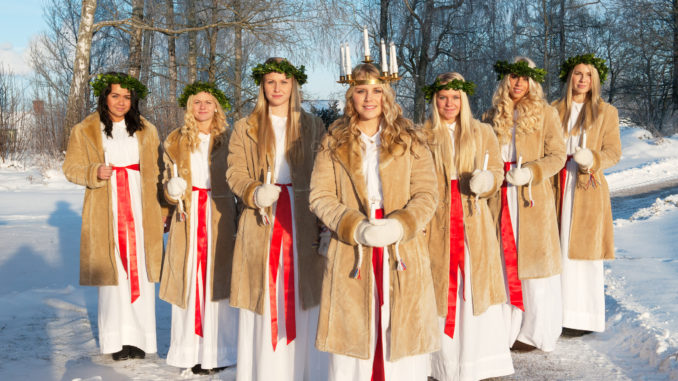By Perla Lepage, Year 12
Sankta Lucia är en högtid som firas den 13 december. I Sverige ingår högtiden tillsammans med advent i förberedelserna till julfirandet. Lucia är en av de mest kända traditioner som firas av både svenskar i Sverige och svenskar utomlands. Luciafirandet är fullt med sång och mat. På de flesta skolor i Sverige går eleverna i luciatåg med lucior, tomtenissar, tärnor, pepparkaksgubbar och stjärngossar. I de flesta städer firas Lucia med luciatåg i kyrkor, företag, äldreboenden och köpcentrum. Man serverar ofta fika (och kanske frukost) med lussebullar, pepparkakor och glögg. Varje år, förutom 2020 pga pandemin, sänder SVT det nationella luciafirandet från någon plats i Sverige. För många svenskar innebär luciamorgonen att äta frukost framför tv:n och njuta av det vackra luciatåget med sång den kalla vintermorgonen när julen närmar sig.
Sankta Lucia is a tradition which is celebrated on the 13th of December. In Sweden, this celebration, along with Advent, is included in the preparations for the Christmas celebration. Sankta Lucia is one of the most famous traditions which is celebrated by both Swedes in Sweden and abroad. This celebration is full of songs and food. In many schools in Sweden, if not all, the students (and maybe some teachers) go in a lucia-procession with Lucias, santas, maidens, gingerbread men and star boys. In many regions in Sweden, there are Lucia processions in the local church and it is celebrated in company offices, retirement homes and malls. With the Lucia celebration one often has fika, a Swedish custom where people gather and eat baked goods, (and maybe even breakfast) with lussebullar, a typical Swedish bakery with saffran, gingerbread cookies and warm wine (with or without alcohol). Every year, except for 2020 due to the pandemic, SVT (the Swedish television channel) transmits the national Lucia celebration from different places in Sweden. For many Swedes, the Lucia morning means eating a Christmas breakfast in front of the tv while enjoying the Lucia procession with song on this cold winter morning as Christmas approaches.
Sankta Lucia, also known as Saint Lucia, one of the earliest Christian martyrs, was killed by the Romans in 304 CE due to her religious beliefs. In Sweden which was catholic at the time, Lucia was the day of a saint until the 1500s. In the late 1700s, the 13th of December became a day to celebrate light in the darkest nights of the year, and this tradition has remained ever since.
We had the opportunity to interview Flora Lepage in Year 9 who celebrates Sankta Lucia every year. She told us about her and her sister’s experience.
What does Sankta Lucia mean to you and your family?
To me, Santa Lucia means my Swedish childhood, where on the 13th of December, my sister and I as well as all of the other children around Sweden would wake up early, put on our white dresses and candles in our hair and get ready to sing for our parents. My sister and I always baked gingerbread cookies, and the typical Swedish christmas bakery “lussebullar ” with saffron and made hot chocolate and coffee for our parents. We would all together have a wonderful Lucia morning before going to school to celebrate it there with all my friends and teachers.
What do you do during the Sankta Lucia celebration?
During the Santa Lucia celebration, in school, all of the girls and boys would stand in a line dressed up in white dresses (for the girls) and white clothing (for the boys) and each holds a candle. Several days earlier, a girl would have been chosen, generally through a lottery, and she would get to be the “Lucia”. She would be the only girl wearing a candle crown in her hair and would be in the front of the procession. Then, we would go around the school singing and to other places like the elderly home across the street. I remember that the last Lucia I had in Sweden before we moved, we sang to the people in the home for the elderly next to the school and they were overjoyed to see us. Several were so touched that they cried, because the impression of the Lucia procession with all the candles and the singing can be that of a procession of angels. We had also brought cookies and candy and they offered us hot chocolate.
How will we be celebrating Sankta Lucia on our campus?
You may wonder what exciting events our campus will offer next Monday, the 13th December, when our campus will be celebrating Sankta Lucia. We will start off with hearing the traditional Sankta Lucia song played in the loudspeakers all around campus from 7:50 to 8:15. Then, a video about the celebration which has been pre-recorded will be shown in class featuring Swedish students. Then during morning break at 10:30 the traditional Sankta Lucia procession will take place, with students from a wide range of years, where you will see Lucia dressed in white with a red sash and lighted crown followed by her maidens. Then at lunch, be ready to taste a typical Swedish delicacy!



